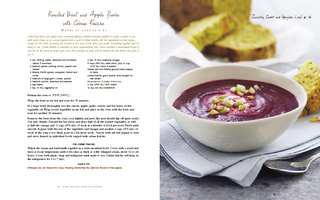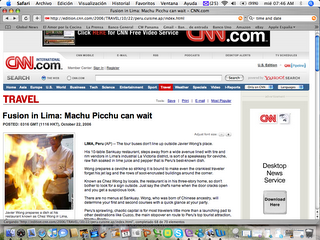
SPAIN REIGNS AT SAN ANTONIO'S NEW WORLD WINE & FOOD FESTIVAL
by Sharon Hudgins
The multicultural cuisine of modern San Antonio, Texas, has been strongly influenced by the city's Hispanic heritage, which dates back to the early 18th century. So "The Reign in Spain" was a natural choice as the theme for San Antonio's 2006 New World Wine & Food Festival, an annual event held for ten days in November.
Chefs from Spain, Mexico, and the United States prepared special dishes for the many luncheons, dinners, grazers, seminars, and tastings offered at the festival. And vintners from Texas to California, Chile, and several regions of Spain showcased their wines alongside the colorful foods.

The festival focused on both the Spanish influence on New World cuisines and trends in contemporary Spanish cooking. Chef Ernie Estrada of Francesca's at Sunset, at the Westin La Cantera Resort, designed a six-course menu featuring two versions of each dish (Spanish and New World) paired with six wines each from Miguel Torres vineyards in the Catalunya region of Spain and from Becker Vineyards in central Texas. Billed as "The Conquistador and the Cowboy," the meal offered comparative dishes such as "Spanish Paella" (with clams, mussels, chorizo, calamari, lobster essence, and osetra caviar) and "Tejas Style Paella" (with striped bass, wild quail, bratwurst, blackened bell peppers, Fuji apples, and apricots).

Janet Mendel—author of Cooking from the Heart of Spain, My Kitchen in Spain, and other classic Spanish cookbooks—collaborated with Chef Shane Bruns at Oro Restaurant and Bar in the Emily Morgan Hotel to produce a menu offering a first course of "Scallop & Lobster Sandwich" with roasted butternut squash purée and preserved lemon beurre fondue, followed later in the meal by monkfish wrapped in Spanish serrano ham, with fava bean and quince ragout and wilted mustard greens.

And at Las Canarias restaurant in the Omni La Mansion del Rio hotel, chefs Jesus Ramiro and Mickey McPhail teamed up to make an especially memorable Spanish goat cheese ice cream garnished with caramel sauce and pine nuts, two popular Spanish flavors.
Flashing his long knife at several of the festival events was Florencio Sanchidrían, "The Offical Ham Slicer for the King of Spain." Looking more like a pirate on a Spanish galleon than a contemporary culinary professional, Sanchidrían demonstrated his technique for cutting paper-thin slices of Spain's renowned jamón serrano, dry-cured ham produced in several regions of Spain (and now increasingly available at specialty food stores in the United States). Sanchidrían certainly knows his craft: he holds the world's record for cutting the longest continuous piece of serrano ham (more than 40 feet of flesh).
The innovative cooking of today's Spanish and American chefs was especially apparent in the preparation of tapas, those "little bites" of food whose popularity has spread from Spain across the globe. Traditional tapas bars serve such tidbits as cubes of Spanish manchego cheese marinated in olive oil, thin slices of pink serrano ham, tiny casseroles of mushrooms sautéed with garlic, and wedges of thick potato omelets known as tortillas in Spain.

But at San Antonio's wine-and-food festival, several chefs took traditional tapas to another level. Spanish chef Javier Núñez "deconstructed" those popular potato omelets into shooters of liquid egg topped with potato "foam" and turned simple ham-and-tomato sandwiches inside out, with crunchy slices of Spanish serrano ham enclosing a filling of puréed bread, tomatoes, and olive oil.
"These are examples of modern tapas that Spain has come up with," said Gerry Dawes, an expert on Spanish foods and wines, at a seminar on "Transcendent Tapas" in San Antonio.
"The flavors aren't really different," said Dawes, "but there's a different way of presenting them."
At the same seminar Jason Dady, chef at The Lodge Restaurant of Castle Hills and at Bin 555 Restaurant and Wine Bar, presented his own take on Spanish tostadas, open-faced sandwiches made from slices of toasted bread brushed with olive oil and topped with a variety of ingredients. Once you've tasted his chocolate-and-chorizo tostadas, spiced with vanilla-scented sea salt, you'll wonder why you never thought of this felicitous combination yourself!
RECIPE
Chocolate-Chorizo Tostadas
Country-style (chewy-textured) French bread, cut crosswise into 1/2-inch-thick slices
Spanish extra-virgin olive oil
Nutella (chocolate-hazelnut spread)
Vanilla-bean-flavored fleur de sel (or other fleur de sel) sea salt
Spanish chorizo sausage, cut crosswise into 1/8-inch-thick slices (not Mexican soft chorizo sausage)
Toast the bread slices on both sides and let them cool. Lightly brush one side of each bread slice with olive oil, then spread a thin layer of Nutella on top (like spreading mayonnaise on sandwich bread). Sprinkle a small amount (a pinch or two) of sea salt evenly over the Nutella, then place two or three slices of chorizo in a single layer on top. Serve at room temperature, as an appetizer or snack, accompanied by a robust Spanish red wine from the Rioja region.
NOTE: Make vanilla-scented fleur de sel sea salt by finely crushing a vanilla bean and combining it with the salt in a tightly covered glass container. Let the mixture stand for several days for the flavors to meld.
Source: Jason Dady, The Lodge Restaurant of Castle Hills (San Antonio) and Bin 555 Restaurant and Wine Bar (Dallas and San Antonio)
Sharon Hudgins is a food writer who has lived in Spain and is the author of an award-winning cookbook about the regional cuisines of Spain.
©2006 Sharon Hudgins
SHARON HUDGINS
2516 High Pointe Blvd.
McKinney, TX 75071
Tel/Fax: (972)-548-4866
E-mail: swhudgins@earthlink.net







































